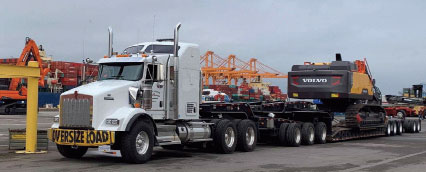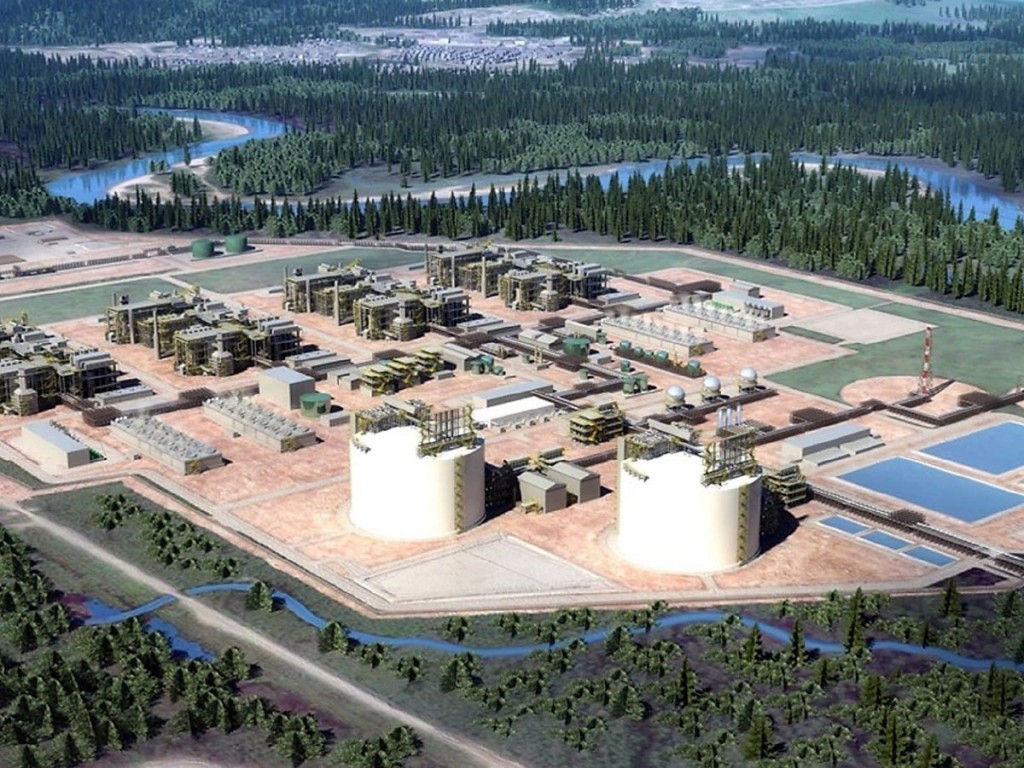In British Columbia, Kitimat’s $40 billion LNG export terminal is one of Canada’s largest projects – the largest energy undertaking in Canadian history. It’s estimated it will eventually generate over a million tons of breakbulk and project freight. So, where is all that freight coming from?
The most visible evidence of Canada’s ambitions to be a natural gas export powerhouse for Asian markets is steadily taking shape. This is despite construction delays caused by the COVID-19 pandemic and mounting criticism by heavy haul carriers of serious inefficiencies in British Columbia’s permit system governing over-dimensional loads.

Developing the massive project are Shell, PetroChina, Malaysian-owned Petronas, Mitsubishi, and Korea Gas Corporation. The engineering, procurement, and construction components involve joint venture partners Fluor (based in Houston) and JGC of Yokohama, Japan.
Comprising two LNG trains (processing units) in the first phase, the LNG Canada terminal will have the capacity to export 14 million metric tonnes a year (Mtpa) of LNG over its estimated project life of up to 40 years. There is potential to expand to four trains and 28 million tons annually for export.
The first phase will also comprise two LNG storage tanks of 225,000m³ each, a marine terminal capable of accommodating two LNG carriers at a time, a rail yard to load condensates, a water treatment facility, and two flare stacks of 60m and 125m height.

An existing wharf at the Kitimat Port previously owned by Rio Tinto Aluminium BC is being redesigned as the marine terminal facility for LNG Canada. Upon reaching full capacity, the export terminal is expected to be visited by about 350 LNG ships a year, with each ship capable of loading up to 170,000m³ of LNG. In phase one, the frequency is expected to be one ship call every other day.
During the first half of this year, Spruce Hollow Heavy Haul, a Canadian and US-bonded carrier based in Abbotsford, BC, near the US border, played a substantial role in moving construction equipment from the Port of Tacoma to the Kitimat region. It trucked 194 heavy-duty excavators, weighing between 40 and 54 tons, on a journey exceeding 1,000 miles for building the LNG Canada facility and the 420-mile pipeline destined to supply it.
The Permitting Issue
“Because Spruce Hollow is a local carrier well-versed in the BC permitting restrictions, Andersen Trucking Services (ATS) of Minnesota made arrangements with Spruce Hollow for transporting everything going north from Tacoma,” said Ron Madill, co-owner and general manager of the Canadian heavy haul enterprise which has close relations with especially the ports of Vancouver, Tacoma and Seattle. ATS oversaw the logistics planning for a European construction equipment manufacturer.
Spruce Hollow also handled the transport of 154 excavators for Japanese and other Asian equipment manufacturers.
The equipment loaded in Asia and Belgium was carried by Ro-Ro carrier Wallenius Wilhelmsen to Tacoma where it was briefly stored.
In a telephone interview with the American Journal of Transportation, Madill pointed out: “85 percent of the freight we move for either BC or Alberta comes through Washington state, Oregon or Texas (Houston).

“You also have Grays Harbour in Aberdeen, Washington state, which used to be a military port but has developed in recent years into a breakbulk hub. In fact, during COVID, more than 60% of the cargo sitting in the port has been Canada bound.”
Moving the excavators during the winter months presented special challenges that had to be overcome, Madill said, adding that in remote locations the local knowledge of indigenous people was invaluable. “In some areas, we had to take the machinery in on rig-mats (timbered formats) on thawing, mushy roads.”
Under normal circumstances, the hauler uses seven-to-nine axle removable goose neck trailers because regulations permit 34,000 pounds per axle any time of the year. But it must go up to 10-to-12 axle units to redistribute weight in order to reduce loads to 80% of the normal gross axle weight.
Under phase two, the transport of 84 pieces into Canada was supposed to start in late August.
“However, it is still on hold because of contractual issues,” said Madill. “We know a lot of the equipment has arrived in Tacoma and it is being stored there. This includes rock trucks, bulldozers, the first 190,000-ton units that are 80% excavators of various sizes.”
Looking back at the positives, Madill indicated that “over a 3-4 month period, we had a 35% increase in volume of breakbulk cargo-orientated moves. This wasn’t the standard rule in our industry. We were, in fact, fortunate to be in the pigeon hole at the time.”
BC permitting system likened to ‘horse-and-buggy era’
But like many of his peers in British Columbia, Madill is up in arms over the existing permitting system in the province.
“Most breakbulk forwarders are avoiding ports in British Columbia. It’s either a bureaucratic nightmare or a timing issue,” he said, adding: “The provincial government listens to itself and not enough to industry.”
Yet, early in 2020, the BC government introduced new project cargo corridor permits for commercial vehicles travelling between two Greater Vancouver terminals, Lynnterm and Fraser Surrey Docks, and where highway 16 crosses the Alberta border. Trucks using the routes from the two terminals were absolved from completing the traditional extraordinary load approval process.
But this has been dismissed as a piecemeal approach by the Port of Vancouver and the BC Trucking Association (BCTA) – observing, among other things, that the corridor only applies to cargoes moving to and from those two terminals. Thus, if a load meeting the size requirements but originating from another port, such as Seattle or Tacoma, it cannot qualify for a streamlined permit - and this can take up to 12 business days, admits the BC Ministry of Transportation and Infrastructure (MOTI).
In its latest salvo addressed to the provincial ministry in mid-September, the BCTA stated: “BCTA has been requesting action on frustrations experienced by members hauling oversize-overweight loads regarding permit turnaround times for a number of years. Specifically, members have reported processing times of 25 days or more, when neighbouring jurisdictions are issuing permits for the same loads in much shorter timeframes and in some cases on the same day. We have asked MOTI three times over the past two years to deal with an antiquated system that continues to be primarily manual, paper-based, understaffed and far too complex.
“The likelihood of the international shipping community to use US ports and avoid BC because of these challenges is well known. More recently, it has come to our attention that the Province is aware that a high percentage of carriers are moving loads in the province without a permit.”
The trucking association has called for a comprehensive review of the regulatory framework and to consider general authorization for term permits and expedite the development of an online permit system.
Meanwhile, not hiding his exasperation, Madill comments: “We are not in the horse-and-buggy era. The rest of North America, including Alberta, Washington State, have gone to electronic permitting. To move 200,000 pounds, for instance, in Tacoma, you can get a permit within 5 to 7 days. In BC, every move is an independent move. As a result, the costs of doing breakbulk in BC, when items are sitting on docks or on trucks for many days, go up exponentially.”

